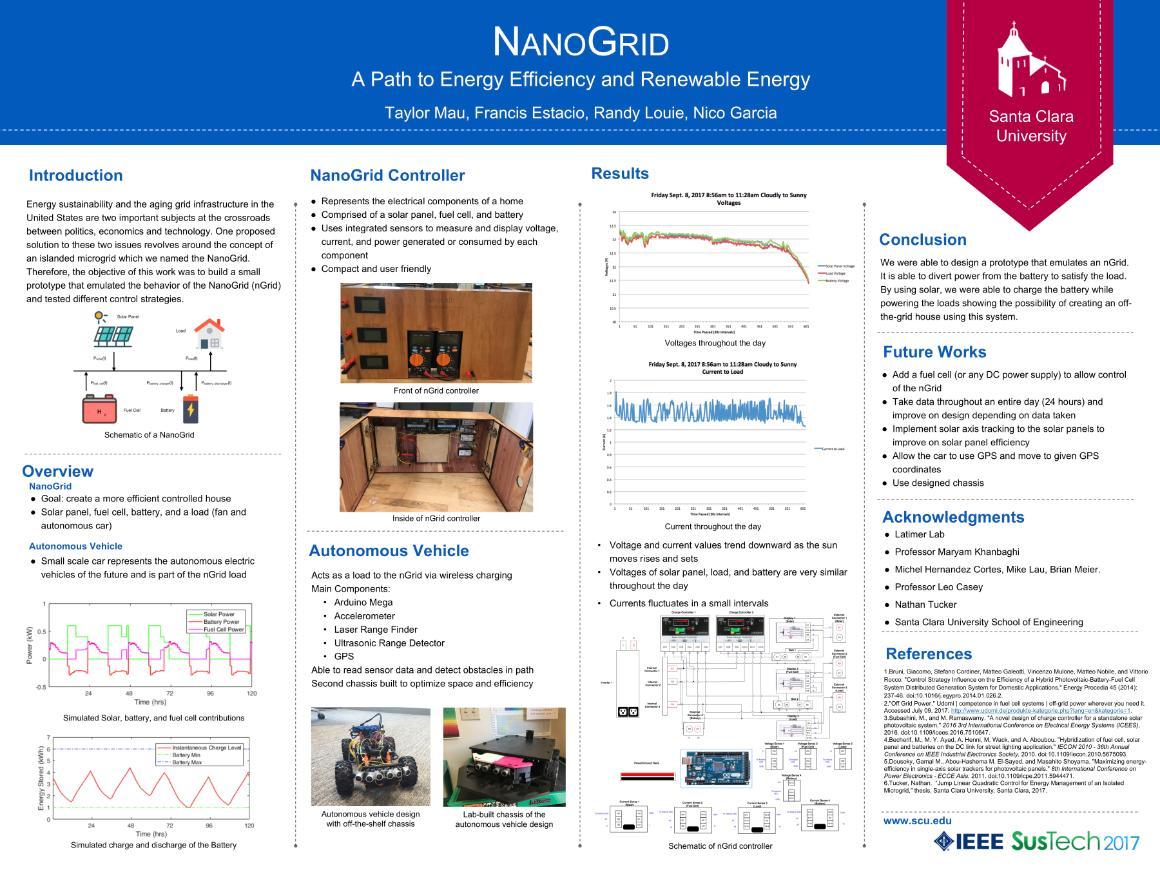
NanoGrid
NanoGrid
A Path to Energy Efficiency and Renewable Energy
Taylor Mau, Francis Estacio, Randy Louie, Nico Garcia
Introduction
Energy sustainability and the aging grid infrastructure in the United States are two important subjects at the crossroads between politics, economics and technology. One proposed solution to these two issues revolves around the concept of an islanded microgrid which we named the NanoGrid. Therefore, the objective of this work was to build a small prototype that emulated the behavior of the NanoGrid (nGrid) and tested different control strategies.
Overview
NanoGrid
- Goal: create a more efficient controlled house
- Solar panel, fuel cell, battery, and a load (fan and autonomous car)
Autonomous Vehicle
- Small scale car represents the autonomous electric vehicles of the future and is part of the nGrid load
- Arduino Mega
- Accelerometer
- Laser Range Finder
- Ultrasonic Range Detector
- GPS
NanoGrid Controller
- Represents the electrical components of a home
- Comprised of a solar panel, fuel cell, and battery
- Uses integrated sensors to measure and display voltage, current, and power generated or consumed by each component
- Compact and user friendly
Autonomous Vehicle
Acts as a load to the nGrid via wireless charging
Main Components:
- Arduino Mega
- Accelerometer
- Laser Range Finder
- Ultrasonic Range Detector
- GPS
Able to read sensor data and detect obstacles in path
Second chassis built to optimize space and efficiency
Results
- Voltage and current values trend downward as the sun moves rises and sets
- Voltages of solar panel, load, and battery are very similar throughout the day
- Currents fluctuates in a small intervals
Conclusion
We were able to design a prototype that emulates an nGrid. It is able to divert power from the battery to satisfy the load. By using solar, we were able to charge the battery while powering the loads showing the possibility of creating an off-the-grid house using this system.
Future Works
- Add a fuel cell (or any DC power supply) to allow control of the nGrid
- Take data throughout an entire day (24 hours) and improve on design depending on data taken
- Implement solar axis tracking to the solar panels to improve on solar panel efficiency
- Allow the car to use GPS and move to given GPS coordinates
- Use designed chassis
Acknowledgments
- Latimer Lab
- Professor Maryam Khanbaghi
- Michel Hernandez Cortes, Mike Lau, Brian Meier.
- Professor Leo Casey
- Nathan Tucker
- Santa Clara University School of Engineering
Click here to view the PDF poster of NanoGrid, A Path to Energy Efficiency and Renewable Energy